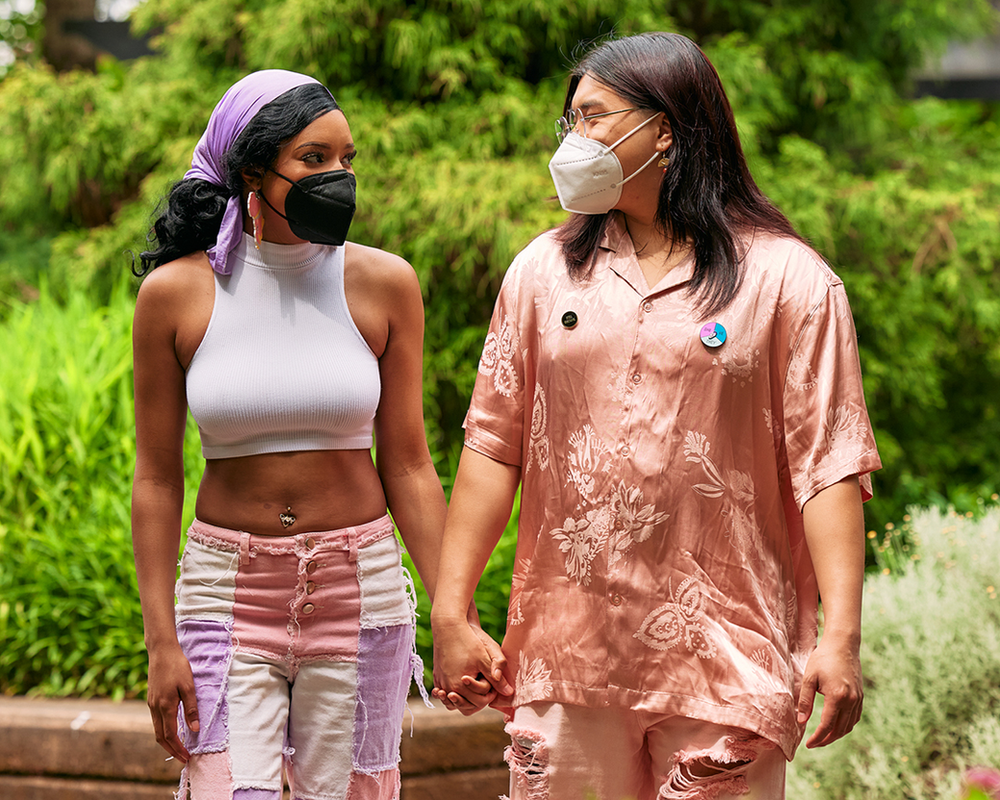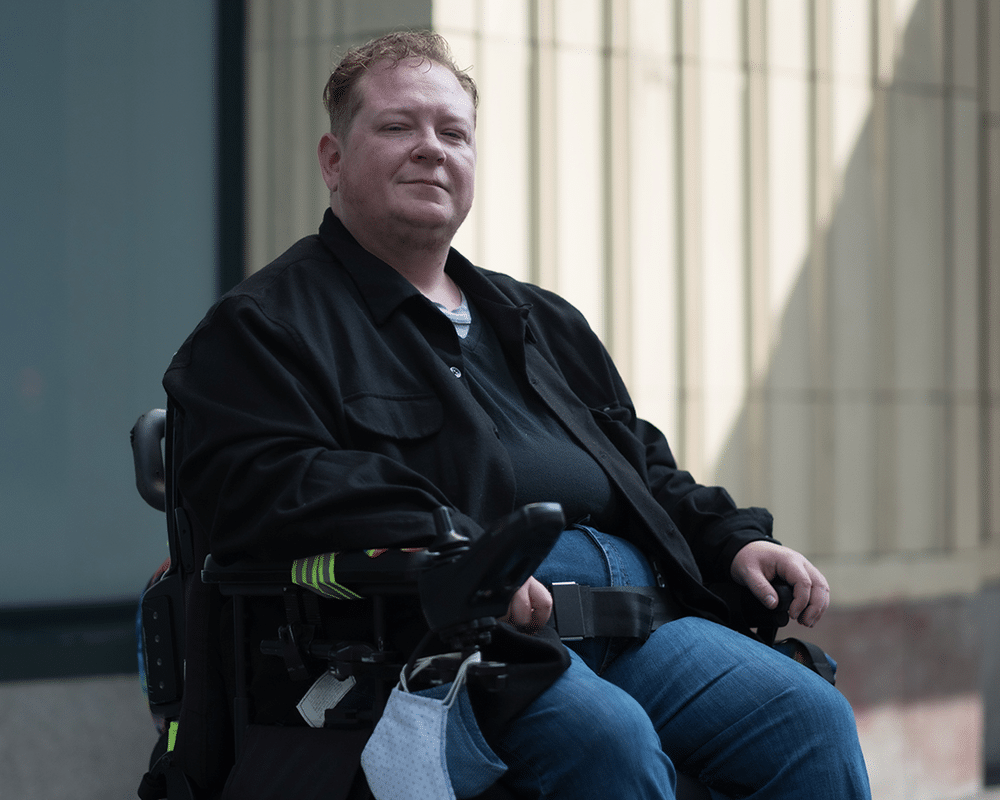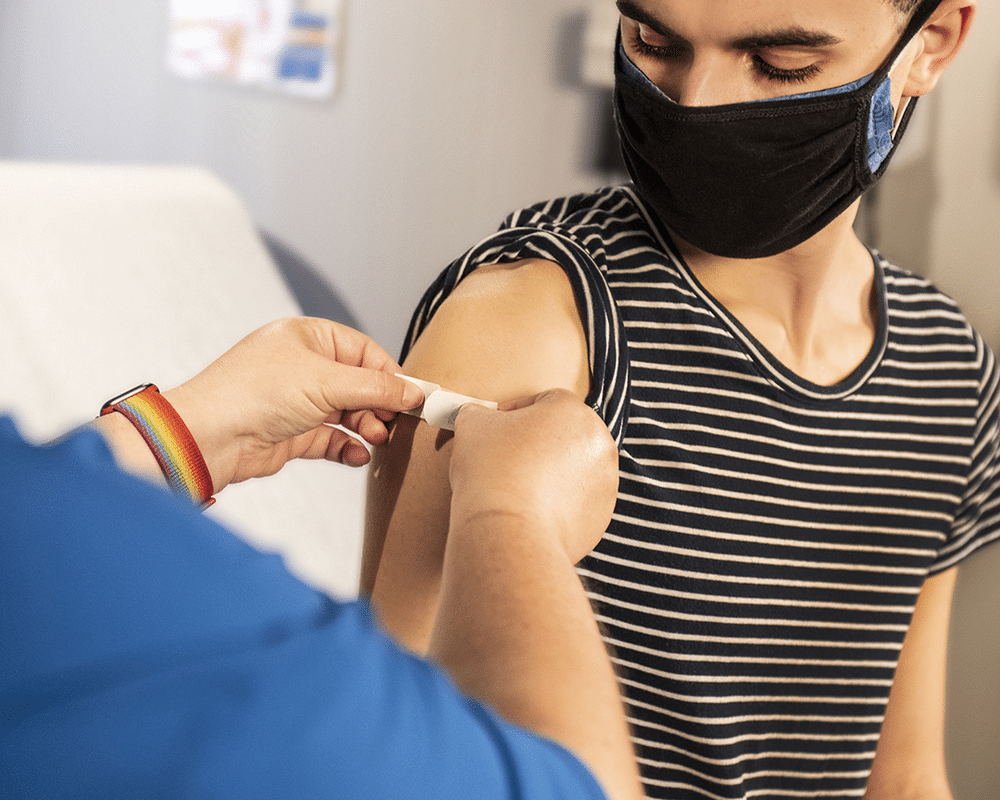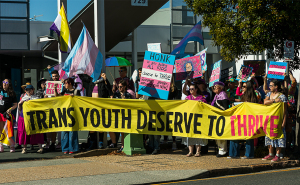This article was originally published by the Trans Health Research team. You can find the original article here.
Authors: Bec Ward-Smith and Dr Sav Zwickl.
Content Warning: Mention of mental health; discussion of COVID-19 vaccination and COVID-19 illness.

A non-binary person and a woman walking together, holding hands. Both are wearing face masks. Image credit: Disabled and Here.
Our ,TRANSform, project was launched during the first nation-wide COVID-19 lockdowns and we have placed significant focus on capturing the experiences of our community during the pandemic. In a survey we conducted in May 2020, over 1000 trans and gender diverse people shared their experiences of the early months of the pandemic, including widespread job loss, financial strain, healthcare disruptions and mental health distress. These findings were published in the ,International Journal of Transgender Health,, and the ,Trans in the Pandemic Report and shared widely with ,federal and state government, as well as media (e.g. ,ABC News and ,SBS,).
In May 2022, we followed up with the same group of trans people (516 responded), to assess how they were fairing over two years into the pandemic. In addition to mental health impacts, this time we also focused on rates of COVID-19 testing, vaccination, and infection.
Recently published in the ,Medical Journal of Australia, one of the key findings was that while trans people are more likely than the general population to have received three COVID-19 vaccine doses, they are also more likely to report long-term symptoms of COVID-19 infection.
What is Long-COVID?
Long COVID is a term used to describe both:
- ongoing symptomatic COVID-19 – COVID-19 symptoms lasting more than 4 weeks, and
- post-COVID-19 condition/syndrome – COVID-19 symptoms after 12 weeks that are not explained by an alternative diagnosis.
Long COVID can present differently in different people and symptoms can range from mild to severe.
The ,Australian Department of Health report that the most common symptoms with Long COVID are fatigue (tiredness), shortness of breath, and problems with your memory and concentration (‘brain fog’).
There are also many other symptoms, including heart palpitations, chest pain or tightness, cough, changes in taste or smell, joint and muscle pain, pins and needles, problems sleeping (insomnia), changes in mood (increased worry, anxiety, or depression), dizziness, headache, low-grade fever, skin rashes, hair loss, nausea, diarrhoea, stomach aches, and loss of appetite. A ,recent study also found additional symptoms including sneezing, ejaculation difficulty, and reduced libido.
No matter how severe, Long COVID symptoms can have a significant negative impact on quality of life and one’s ability to engage in study, work, leisure, and relationships. For example, a trans woman who completed our survey shared her experience of severe and long-term health issues following COVID-19 infection:
“Long COVID made me so sick I couldn’t do things like go to the doctor and my [gender-affirming hormone therapy] was disrupted for a while…. It kind of hurts seeing people get back to life ‘as normal’ while my life has been trashed. It has also been a uniquely isolating experience as a trans woman… I have had more trouble with misgendering since being sick. I don’t know, I guess I don’t look as femme when I am haggard from illness and can’t take care of my appearance.”
Why are trans people at higher risk of Long COVID?
In our study of 516 trans Australians, 37% of those with previous COVID-19 illness reported ,long term health consequences of COVID‐19 (e.g., fatigue, brain fog three or more months after acute illness). This is much higher than the ,,estimated 5–10% of the general Australian population who report such symptoms after COVID‐19 illness.
This finding is similar to the experiences of trans and gender diverse people in the USA. In the ,Household Pulse Survey conducted by the Census Bureau in December 2022, ,46% of trans respondents reported experiencing long term COVID symptoms, compared to 32% of cisgender women and 22% of cisgender men. Trans people also reported severe Long COVID symptoms at more than four times the rate of cisgender women and men.
Although we do not entirely understand Long COVID illness, it is recognised that some marginalised groups are at higher risk of severe long-term symptoms. This is likely for two reasons.
Firstly, the trans community experience high rates of ,chronic ,health conditions and disease, and ,mental, ill-health. This high prevalence is related to social factors and ,minority stress which are known to negatively impact both physical and mental health. Health conditions or disease and mental ill-health prior to COVID-19 are both known ,risk factors for Long COVID.
Secondly, the trans community experience unique barriers to accessing health care. This includes ,difficulty finding a trans-affirming doctor, and previous or anticipated negative experiences; over half of our survey respondents reported ,one or more experience of health discrimination since the start of the pandemic.
The impact of factors like chronic health conditions, mental ill health and barriers to accessing health on the experience of Long COVID for 14 people was demonstrated by ,researchers in Australia. They found that people who felt a greater sense of ‘agency’ or control over their healthcare, combined with higher levels of social support, reported a “better experience” managing their symptoms of Long COVID. Those with lower ‘agency’, and who felt lonely or isolated, had a harder time coping with their Long COVID symptoms.

A disabled trans man in his powerchair, with masks secured to the powerchair. Image credit: Levi Meir Clancy.
How can trans people protect themselves from Long COVID?
The best way to prevent Long COVID is to ,,protect yourself from getting COVID-19. Reducing the risk of infection may involve avoiding high-risk settings such as crowded indoor areas, maintaining physical distance from other people, maintaining good hygiene including use of hand sanitiser, and wearing masks where possible. These prevention measures have been increasingly difficult to follow as we have eased social restrictions and there is widespread transmission of COVID-19.
For some trans people, the risk of COVID-19 infection and serious illness is too great, forcing them to limit their access to public spaces and in-person gatherings, including LGBTIQA+ community events and support groups. There are many people who feeling anxious, frustrated, and isolated by the lack of precautions to minimise spread of COVID-19. For example, a trans non-binary person shared with us how:
“As a disabled person, I feel increasingly isolated from abled queer and trans community members who are taking less and less precautions to keep vulnerable community members safe.”

A nurse putting a band-aid on a person who has just been vaccinated. Image credit: CDC.
Vaccination provides protection against severe illness from COVID-19 in a couple of ways. ,All COVID-19 vaccines that are available have consistently been shown to provide protection against severe illness, and ,potentially Long COVID. Whilst vaccination will not prevent the transmission of COVID-19, it has been shown consistently to prevent severe illness.
Additionally, ,hybrid immunity is maintained through high rates of vaccination amongst the general Australian population, combined with the immunity provided by the population’s past COVID-19 infections. Hybrid immunityprovides protection for people who are at higher risk of severe illness from COVID-19 but needs to be combined with vaccination to be most effective at reducing this risk.
The first COVID-19 vaccines targeted the original strain of the SARS-COV-2 virus. Studies have shown that over time, the effectiveness of initial COVID-19 immunisation reduces, and ‘booster’ doses are recommended according to a person’s risk of severe illness from COVID-19.
While studies overseas indicate social stigma, fear of discrimination, and mistrust of health care professionals contributed to COVID‐19 ,,vaccine hesitancy among trans people, in Australia trans people showed up in large numbers to receive their vaccination. As of May 2022, 87% of trans people who completed our survey reported having three or more COVID‐19 vaccine doses, compared to ,,70% of the general population. These high rates of vaccination are likely due to vaccines being more accessible and less politicised than in many other countries. Additionally, there were also some targeted vaccination campaigns and promotions, such as the Victorian Government ,#FabJab,, initiative with its pop‐up LGBTIQA+ vaccination clinics and specific advice being made accessible on the ,,TransHub website in New South Wales.
An important reason to keep up with COVID-19 boosters is to maintain protection against the new variants of COVID-19, as well as to do our bit in maintaining hybrid immunity to protect our community members who are at higher risk of severe illness from COVID-19.
Newer vaccines target current circulating strains and are now considered the preferred COVID-19 vaccines from ages 4+. With the recent increase in COVID-19 cases across the country with a new Omicron subvariant, the Australian Technical Advisory Group on Immunisation (ATAGI) have recently updated the ,recommendations for a 2023 booster dose. There are 3 vaccines that have been shown to provide immunity to this new subvariant and are now available. As the festive season arrives, now is a good time to consider if you are due for your 2023 booster – it’s not too late. You can find a list of local GP clinics and pharmacies to get vaccinated ,here.
Finally, if you do get COVID-19 and are at high risk of becoming very sick, it is important to have a plan in place with your GP or nurse practitioner. ,Oral anti-viral treatments are now much more widely available than early in the pandemic and are low-cost. For people who are eligible for oral anti-virals, treatment needs to be started within the first 5 days of getting sick, so it’s important to reach out to your GP or nurse practitioner as soon as you suspect you have COVID-19 or have a positive RAT test.
About the authors
Bec Ward-Smith is a critical care registered nurse and senior research officer with a background in psychology. They are trans non-binary.
Dr Sav Zwickl is a Research Fellow with the Trans Health Research. They have a Masters degree in Sexology, a PhD in Gender, Sexuality and Diversity Studies, and experience in LGBTIQA+ peer support.



